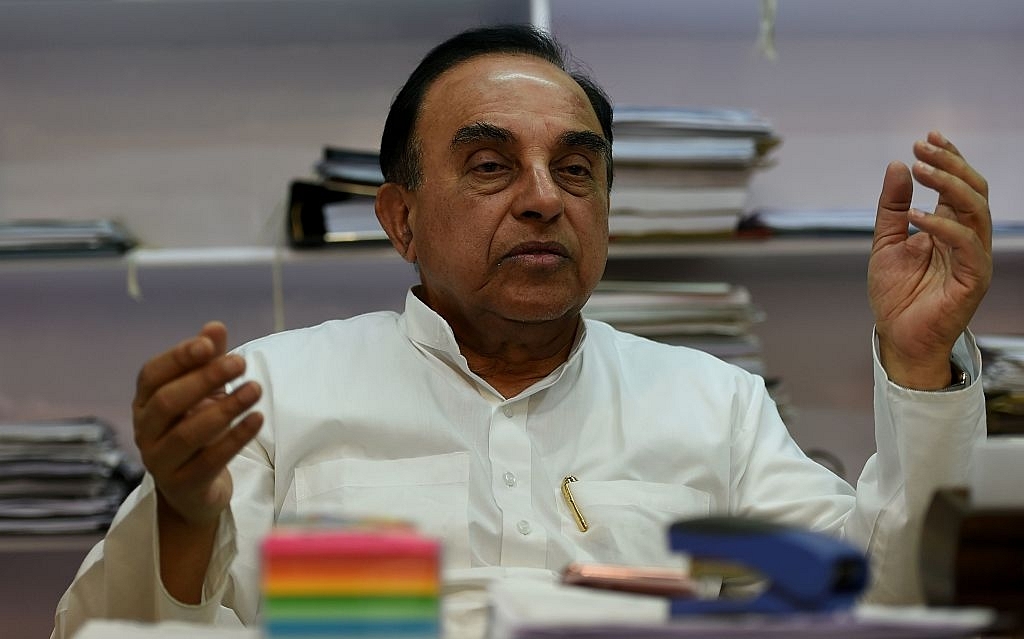Economy
Economics 101 For Swamy: Why Is He Feeding On Failed Keynesian Ideas?

S Swamy (Photo: MONEY SHARMA/AFP/Getty Images)
It’s an irony that Subramanian Swamy claimed that his Rajya
Sabha nomination was for his excellence in economics. Swamy has many
achievements to his credit in the recent past, most notably his fight against big-ticket
corruption by the UPA government, his fight for some Hindu causes, et al. But I
would certainly exclude his economic thoughts from the long list of successes.
Before proceeding further, I would have to place some
historical credit where it is due. Much of the economic reforms of the early
nineties that are attributed to Manmohan Singh should rightfully be placed on
the shoulders of Subramanian Swamy. Manmohan was no liberaliser and his
instinctive economic approach was to use the “visible hand of the government”
to guide market outcomes – MNREGA, public-private partnerships, etc. All of
these policies are disastrous from an economic stand-point and it’s hard to
envisage such a diehard neo-Keynesian being an advocate for market solutions as
was done. To his credit and on account of his belief in karma, Swamy has
largely stayed silent and allowed Manmohan Singh to reap the praise for what were
essentially his ideas and policies. Despite what follows hereafter in this
article, I applaud Swamy for it.
A lot has been written criticising Swamy’s attacks on
Rajan, but not many have focused on the economic fallacy of his arguments for
lowering interest rates. Swamy essentially calls for an expansionary monetary
policy to counter the economic slowdown in the Indian economy. He further
quotes the Keynesian theory on the causes of the Great Depression and states
that Rajan, being aware of the theory, must be willfully keeping interest rates
high to intentionally destroy the economy. That is his central premise.
Other arguments such as Rajan being “mentally not
fully Indian” (MNFI), etc, are not even worth going into. Even if it’s true
that Rajan is MNFI, I would any day prefer a MNFI Rajan to the MFI economic
illiterates we have had prior to Rajan, or, for that matter, the ones that are
likely to follow. I would any day prefer a MF American Jim Grant to MNFI Rajan.
The requirement of the job is primarily outstanding economic credentials/track-record
and a commitment to delivering a sound monetary framework. Very little outside
of these is necessary – especially in a world that is bereft of sound monetary
ideals and where the bond vigilantes have been asleep for decades.
Returning to Swamy’s fallacies, one would have thought
that Keynesian ideas for a monetary stimulus would have died along with the
stagflationary seventies. If not then, at least with the ongoing two decades of
Japanese experiments or and the US’s own seven years with ZIRP – zero interest
rates policy. Apparently it has not, and loose monetary policies seem to click
with economic professors as a solution to problems caused by loose monetary
policies in the first place.
Murray Rothbard wrote the best ever thesis of
“America’s Great Depression” (a book by the same name). While summarising a Rothbard
book into a few lines would be injustice, I will attempt the same here. Post-1921,
the US fed engineered a stock market bubble though loose monetary policies and,
like all bubbles, this one had to burst, which it did in 1929. Instead of
allowing the market cleansing process and liquidation of bad debt, initially the
Hoover, and later, the Roosevelt administrations repeatedly intervened to
prolong and worsen what would otherwise have been a deep but short recession.
Those interested, can download the book
and unlearn the Keynesian thesis which is nothing but propaganda unleashed by
the US Fed/government to usurp power from the markets.
So for Swamy to argue as if the Keynesian thesis is
gospel truth demonstrates his economic ignorance. I don’t know if Rajan
subscribes to the above Keynesian thesis, but it’s quite unlikely that he does.
Even if he does, it doesn’t automatically follow that he should be cutting
interest rates in India today. The period of 1929 to 1936 in the US saw a
cumulative deflation of 18 percent, while that’s hardly the case in India.
So essentially Swamy’s economic thesis is wrong and even otherwise, his remedial measures of interest rate reductions do not automatically flow from it. The bylanes of Mylapore are hardly a credible place to vet economic ideologies, much as Swamy might claim support for the same. So instead of sending Rajan to Chicago, Swamy would do himself and India a lot of good, if he can take a sabbatical and go to Auburn (Headquarter of the Mises Institute) and learn some real economics.
Further Reading
Introducing ElectionsHQ + 50 Ground Reports Project
The 2024 elections might seem easy to guess, but there are some important questions that shouldn't be missed.
Do freebies still sway voters? Do people prioritise infrastructure when voting? How will Punjab vote?
The answers to these questions provide great insights into where we, as a country, are headed in the years to come.
Swarajya is starting a project with an aim to do 50 solid ground stories and a smart commentary service on WhatsApp, a one-of-a-kind. We'd love your support during this election season.
Click below to contribute.
Latest